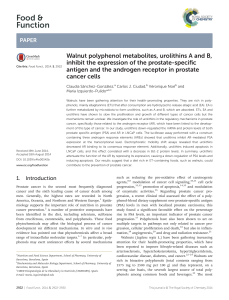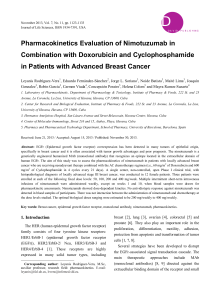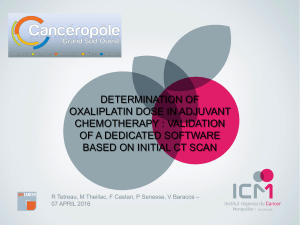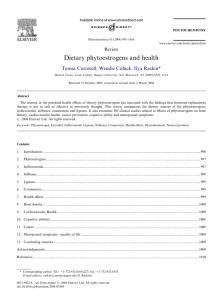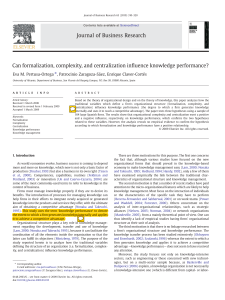Positive interactive radiosensitisation in vitro with the combination
publicité
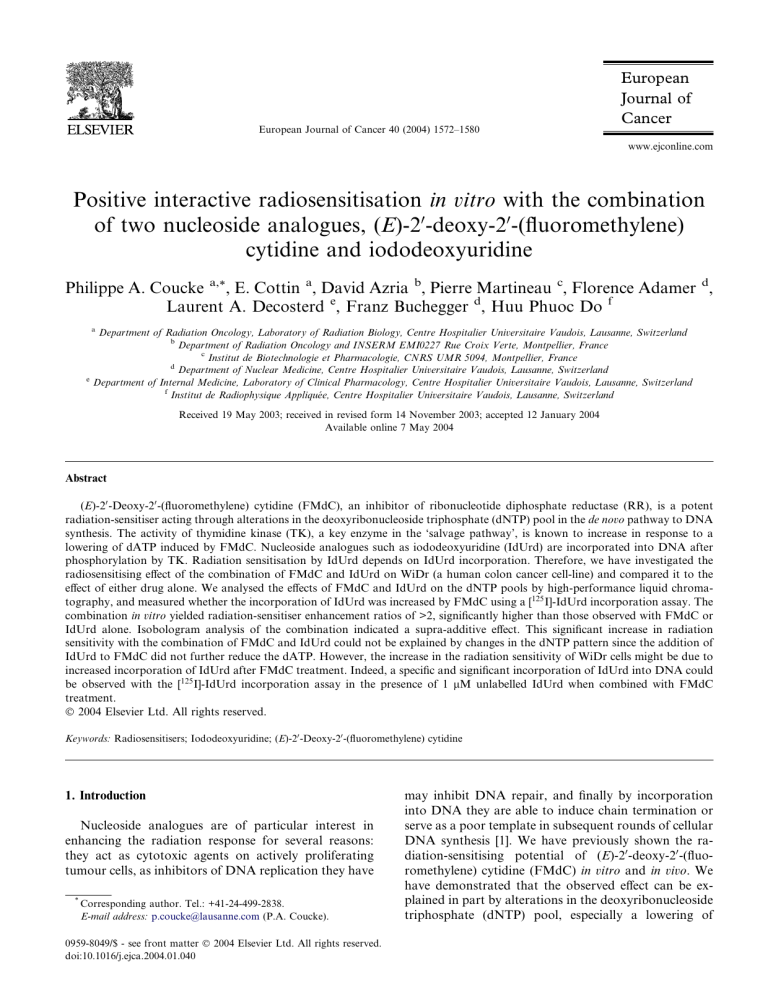
European Journal of Cancer 40 (2004) 1572–1580 European Journal of Cancer www.ejconline.com Positive interactive radiosensitisation in vitro with the combination of two nucleoside analogues, (E)-20-deoxy-20 -(fluoromethylene) cytidine and iododeoxyuridine Philippe A. Coucke a,*, E. Cottin a, David Azria b, Pierre Martineau c, Florence Adamer d, Laurent A. Decosterd e, Franz Buchegger d, Huu Phuoc Do f a e Department of Radiation Oncology, Laboratory of Radiation Biology, Centre Hospitalier Universitaire Vaudois, Lausanne, Switzerland b Department of Radiation Oncology and INSERM EMI0227 Rue Croix Verte, Montpellier, France c Institut de Biotechnologie et Pharmacologie, CNRS UMR 5094, Montpellier, France d Department of Nuclear Medicine, Centre Hospitalier Universitaire Vaudois, Lausanne, Switzerland Department of Internal Medicine, Laboratory of Clinical Pharmacology, Centre Hospitalier Universitaire Vaudois, Lausanne, Switzerland f Institut de Radiophysique Appliquee, Centre Hospitalier Universitaire Vaudois, Lausanne, Switzerland Received 19 May 2003; received in revised form 14 November 2003; accepted 12 January 2004 Available online 7 May 2004 Abstract (E)-20 -Deoxy-20 -(fluoromethylene) cytidine (FMdC), an inhibitor of ribonucleotide diphosphate reductase (RR), is a potent radiation-sensitiser acting through alterations in the deoxyribonucleoside triphosphate (dNTP) pool in the de novo pathway to DNA synthesis. The activity of thymidine kinase (TK), a key enzyme in the ‘salvage pathway’, is known to increase in response to a lowering of dATP induced by FMdC. Nucleoside analogues such as iododeoxyuridine (IdUrd) are incorporated into DNA after phosphorylation by TK. Radiation sensitisation by IdUrd depends on IdUrd incorporation. Therefore, we have investigated the radiosensitising effect of the combination of FMdC and IdUrd on WiDr (a human colon cancer cell-line) and compared it to the effect of either drug alone. We analysed the effects of FMdC and IdUrd on the dNTP pools by high-performance liquid chromatography, and measured whether the incorporation of IdUrd was increased by FMdC using a [125 I]-IdUrd incorporation assay. The combination in vitro yielded radiation-sensitiser enhancement ratios of >2, significantly higher than those observed with FMdC or IdUrd alone. Isobologram analysis of the combination indicated a supra-additive effect. This significant increase in radiation sensitivity with the combination of FMdC and IdUrd could not be explained by changes in the dNTP pattern since the addition of IdUrd to FMdC did not further reduce the dATP. However, the increase in the radiation sensitivity of WiDr cells might be due to increased incorporation of IdUrd after FMdC treatment. Indeed, a specific and significant incorporation of IdUrd into DNA could be observed with the [125 I]-IdUrd incorporation assay in the presence of 1 lM unlabelled IdUrd when combined with FMdC treatment. Ó 2004 Elsevier Ltd. All rights reserved. Keywords: Radiosensitisers; Iododeoxyuridine; (E)-20 -Deoxy-20 -(fluoromethylene) cytidine 1. Introduction Nucleoside analogues are of particular interest in enhancing the radiation response for several reasons: they act as cytotoxic agents on actively proliferating tumour cells, as inhibitors of DNA replication they have * Corresponding author. Tel.: +41-24-499-2838. E-mail address: [email protected] (P.A. Coucke). 0959-8049/$ - see front matter Ó 2004 Elsevier Ltd. All rights reserved. doi:10.1016/j.ejca.2004.01.040 may inhibit DNA repair, and finally by incorporation into DNA they are able to induce chain termination or serve as a poor template in subsequent rounds of cellular DNA synthesis [1]. We have previously shown the radiation-sensitising potential of (E)-20 -deoxy-20 -(fluoromethylene) cytidine (FMdC) in vitro and in vivo. We have demonstrated that the observed effect can be explained in part by alterations in the deoxyribonucleoside triphosphate (dNTP) pool, especially a lowering of P.A. Coucke et al. / European Journal of Cancer 40 (2004) 1572–1580 dATP [2,3]. This pool depends on two enzymatic pathways, the de novo and the salvage. In the first pathway, ribonucleotide reductase (RR) is a key enzyme and serves as a target for FMdC, whereas for the latter thymidine kinase (TK) is the rate-limiting enzyme. It has been shown that an alteration in the dNTP pool, especially as significant a drop in the amount of dATP as is seen after treating cells with FMdC, results in an increase in TK activity (positive-feedback loop). TK catalyses the phosphorylation of iododeoxyuridine (IdUrd) to IdUMP, which is the first step towards the incorporation of this halogenated pyrimidine into DNA. We advanced the hypothesis that by using FMdC we could potentially stimulate TK activity in order to obtain an even higher incorporation of IdUrd and hence a significant increase in the radiosensitising effect of IdUrd [4–6]. Moreover, the possible advantage of this approach is to exploit the difference in TK between tumours and normal tissues, with the possibility that selective incorporation might occur [7]. 2. Materials and methods 2.1. Chemicals and cell cultures FMdC was kindly provided by Matrix Pharmaceuticals, Inc. (San Diego, CA). IdUrd was prepared in the Department of Pharmacy at the University Hospital under lyophilised powder in 200 mg vials. Cell-culture media and supplements were from Gibco BRL (Basel, Switzerland). Fetal calf serum (FCS) was purchased from Fakola AG (Basel, Switzerland). The cell-line WiDr was purchased from the American Type Culture Collection (Rockville, MD). The cells were maintained in minimum essential medium with 0.85 g/l NaHCO3 , supplemented with 10% FCS, 1% non-essential amino acids, 2 mM L -glutamine and 1% penicillin– streptomycin solution. Cells were passaged twice weekly. A test for mycoplasma was routinely performed every 6 months, and found negative for contamination. The doubling time for WiDr under conditions of exponential growth was less than 24 h. 2.2. Irradiation technique and clonogenic assay Exponentially growing cells were trypsinised and seeded in 60 15 mm Falcon Primaria culture flasks with 5 ml medium, allowed to attach and incubated for 24 h before adding the inhibitor of RR. Medium containing the chosen concentration of freshly prepared FMdC (30 nM for 48 h) was added at 0 h and replaced at 24 h. After exposure to the drug, the cells were trypsinised and resuspended in fresh medium at low density. Cells were plated onto 100 20 mm Falcon Primaria culture dishes containing 10 ml medium. IdUrd was added at different 1573 time points (or 48 h before irradiation, i.e., simultaneously with FMdC, or immediately before irradiation) and at different concentrations (0.5, 1 and 2 lM). An exposure for 48 h to IdUrd is expected to reach all cells at least once during a complete cell cycle, taking into account the very fast cycling of WiDr. This is especially relevant for IdUrd exposure, which can only be incorporated into DNA during the S-phase. The cells were irradiated at room temperature with an Oris IBL 137 caesium source at a dose rate of 80.2 cGy/ min. We used a range of single doses from 0 to 8 Gy, with a 2 Gy dose increment. For each radiation dose (0, 2, 4, 6 Gy), four dishes were utilised, both for control and drug-exposed cells. The dishes were incubated at 37 °C in air and 5% CO2 for 2 weeks. The cells were fixed in ethanol, stained with crystal violet, and the colonies were manually counted. Colonies of more than 50 cells were considered survivors. All experiments were done in triplicate. For all data obtained by clonogenic assay, the surviving fraction of drug-treated cells was adjusted for drug toxicity to yield corrected survivals of 100% for unirradiated but drug-treated cells. The effect shown is therefore the sensitising action after the subtraction of the direct cytotoxic effect of each of the drugs. The impact of the different drugs (FMdC and IdUrd) and the combination of each on the radiation sensitivity of the WiDr cell-line was calculated at different survival levels (2%, 20% and 50%). 2.3. Isobologram analysis The detection and measurement of additive or supraadditive radiation–drug interactions raise specific problems that have been discussed by Steel and Peckham [8]. Drug interactions were analysed by constructing ‘an envelope of additivity’ on an isobologram previously described by us and by Kano and colleagues [9,10]. Based on available dose–response curves, we analysed the combined effect of RT and FMdC–IdUrd at 40% survival. Three isoeffect curves were drawn as follows. 2.3.1. Mode I line (solid line in Fig. 3(b)) When the dose of radiotherapy is selected, an incremental effect remains to be produced by FMdC–IdUrd. The addition is performed by taking the increment in doses, starting from zero, that gives log survivals adding up to the limit (in our study, 40% survival). If the two agents were acting additively by independent mechanisms, combined data points would lie near the mode I line. 2.3.2. Mode II a line (lower dotted line in Fig. 3(b)) When the dose of RT is selected, an incremental effect remains to be produced by FMdC–IdUrd. The addition is calculated by taking the increment in doses, 1574 P.A. Coucke et al. / European Journal of Cancer 40 (2004) 1572–1580 starting from the point on the dose–response curve of the RT where the effect of irradiation had ended, that produced log survivals adding up to the considered isoeffect (40%). 2.3.3. Mode II b line (upper dotted line in Fig. 3(b)) Similarly, when the dose of FMdC–IdUrd is selected, an incremental effect remains to be produced by RT. The addition is calculated by taking the increment in doses, starting from the point on the dose–response curve of FMdC–IdUrd where the effect of FMdC– IdUrd had ended, that produced log survivals adding up to the considered isoeffect (40%). If the two agents had acted additively by a similar mechanism, the combined data points would lie near the mode II lines. The total area enclosed by these three lines represents an additive response or an envelope of additivity. When the data points fall to the left of the envelope, the drugs are considered to have had a supra-additive effect (synergism). When the points fall to the right of the envelope, the two drugs are said to have had a subadditive effect. In this case, the cytotoxic effect of the drug combination is superior or equal to that of each agent alone but is less than additive. 2.4. Analysis of dNTP and NTP pools by gradient-elution ion-pair reversed-phase high-performance liquid chromatography (HPLC) Simultaneous measurement of dNTP and NTP in WiDr cells was performed by gradient-elution ion-pair reversed-phase HPLC with a modification of a previously described method reported in detail elsewhere [3]. In brief, exponentially growing WiDr cells were exposed to the drugs at adequate concentration and duration. The cells were trypsinised, washed, centrifuged and resuspended in ice-cold ultrapure water (dilution according to cell count) and deproteinised with the same volume of trichloroacetic acid (TCA) 6% (final applied concentration of TCA, 3%). Acid cell extracts were centrifuged and the resulting supernatants were stored at )80 °C before analysis. Before the HPLC assay, samples were thawed and aliquots of 100 ll were neutralised with 4.3 ll saturated Na2 CO3 solution. In the present series of experiments, aliquots of 25 ll were injected into the HPLC column with satisfactory sensitivity. All experiments were done in triplicate, with the triplication process starting at the cell-culture step to detect variability associated with the culture growth conditions. Results were expressed as the concentration of the four dNTP (expressed in pmol/106 cells) and as the absolute amounts of the four NTPs (as measured by peak NTP areas). The optimisation and full validation of the analytical method are described in detail elsewhere [3]. 2.5. [125 I]-IdUrd incorporation assay WiDr cells were plated at a density of 50,000 cells per well in 24-well plates (Costar, Cambridge, MA, USA). Cells in exponential growth, obtained after 24 h, were used for the present experiments. Cold IdUrd was used from a stock solution to obtain a final concentration of 1 lM per well for 24 h. FMdC was used at various concentrations (1,3, 10, 30 and 100 nM) for 24 h. Cells were incubated for 4 h at 37 °C in medium containing 1 kBq/ ml [125 I]-IdUrd with or without FMdC and/or cold IdUrd. [125 I]-IdUrd radiochemical was prepared from the precursor tributytstannyl-20 -deoxyuridine using iodogen as oxidant according to the method described by Foulon and colleagues (in preparation). After incubation, cells were washed once with cold medium and twice with cold phosphate-buffered saline, harvested with trypsin/EDTA and transferred to 5 ml tubes using 400 ll culture medium. Cells were lysed by adding 0.4 ml of 1 N NaOH and DNA-associated radioactivity was precipitated with 0.4 ml 10% TCA [4]. Tubes with lysed cells were centrifuged at 3000g for 30 min. A half volume was separated and counted (Packard, Cobra QC 5002) as a ‘1/2 supernatant’, another half volume as a ‘sediment + 1/2 supernatant’. Precipitable, DNA-associated radioactivity was determined by subtraction. Assays were performed in quadruplicate. DNA-associated radioactivity measured as counts per minute was normalised according to the number of cells in each well. To check whether we were facing the incorporation of ‘hot’ IdUrd into DNA, unlabelled thymidine (dThd) was used for competitive blocking of the specific incorporation of [125 I]-IdUrd. 2.6. Statistical analysis Data are presented as the mean SEM of three independent experiments. Surviving fractions were compared using a two-sided paired t test. The difference was considered significant if a P-value of 0.05 was reached. Dose–response curves were fitted using a second-degree polynomial regression analysis, yielding a linear quadratic equation. The curve fitting was obtained using Statview 5.0 software on a Macintosh G3 computer. The sensitiser-enhancement ratio (SER) was calculated as the ratio between the radiation doses required to obtain a 2%, 20% and 50% survival level, derived from the linear quadratic equations of the corresponding dose– response curves. 3. Results As expected, the use of a low concentration of FMdC (30 nM/48 h) resulted in a reduction of the shoulder of the radiation dose–response curve of WiDr (Figs. 1, 2(a) P.A. Coucke et al. / European Journal of Cancer 40 (2004) 1572–1580 FMdC(30nM) + IdUrd(2microM/imm) 100 SF% and (b)). The SER with a 48-h exposure to 30 nM FMdC at 2%, 20% and 50% survival were relatively constant and in accordance with previously obtained and published values (the ranges are 1.18–1.24, 1.18– 1.35 and 1.2–1.45, respectively) [2]. The sensitising effect of IdUrd depends on the concentration of the drug and the duration of exposure, as clearly demonstrated in a comparison of the shoulder of the dose–response curves in Fig. 2(a) and (b) and Figs. 1 and 2(a) related to modifications of concentration and exposure duration, respectively. In our hands the SER for a 1 lM concentration and a short duration of exposure (added immediately before irradiation) are 1.10, 1.17 and reaching 1.28 at 2%, 20% and 50% survival, respectively. Doubling the concentration of IdUrd to 2 lM, but keeping the short exposure, yielded SER of 1.12, 1.32 and 1.49, respectively. Using an IdUrd concentration of 1 lM and an exposure time of 48 h before irradiation, the SER were 1.16, 1.27 and 1.39 for IdUrd alone and 1.69, 1.97 and 2.25 for IdUrd and FMdC combined, at 2%, 20% and 50% survival, respectively. This represents a significant increase compared to the SER obtained with the individual drugs. Isobolograms for the FMdC–IdUrd-irradiation interaction were established using an irradiation dose 1575 10 1 Control 0.1 IdUrd IdUrd+FMdC FMdC 10 7.5 5 2.5 0 0.01 Dose Gy Fig. 2. (a) Dose–response curve of irradiated WiDr after (E)-20 -deoxy20 -(fluoromethylene) cytidine (FMdC) (48 h) and iododeoxyuridine (IdUrd) immediately before irradiation. Compare with Fig. 1 to evaluate the effect of exposure duration to IdUrd on the shape of the shoulder. To estimate the effect of the concentration compare the response curve in (a) (0.5 and 1 lM IdUrd) to the one obtained in (b) (2 lM IdUrd). Fig. 1. Dose–response curve of irradiated WiDr cells exposed to 30 nM (E)-20 -deoxy-20 -(fluoromethylene) cytidine (FMdC) (48 h) and 1lM iododeoxyuridine (IdUrd) (48 h). All surviving fractions are corrected for the intrinsic toxic effect of the drugs to allow for direct evaluation of the effect of the compounds on the curve. range from 0 to 4 Gy and IdUrd concentrations ranging from 0 to 3 lM (FMdC was at 30 nM for all the experiments). Using mid-log phase cells, the effect of a dose rate of 80.2 cGy/min and FMdC–IdUrd alone or in combination on cell survival was measured. Isobolograms at 40% survival, based on dose–response curves for the FMdC–IdUrd–RT combination, were determined (Fig. 3(a) and (b)). The experimental data fell to the left of the envelope of additivity (Fig. 3(b)). This observation permits a conclusion concerning a supraadditive effect, suggesting a positive interaction in the mechanism of action of the agents when used in combination with ionising irradiation. The HPLC experiments confirm the known effects of FMdC on the dNTP pool, especially a significant decrease of the dATP (Fig. 4). The addition of IdUrd did not decrease the dATP pool further and did not change the amount of dCTP, dGTP and TTP. Interestingly, 1576 P.A. Coucke et al. / European Journal of Cancer 40 (2004) 1572–1580 provide evidence for increased incorporation of IdUrd when WiDr cells are exposed to FMdC. As radiosensitisation by IdUrd depends on incorporation into the cells [13,14], this translates into a significant increase in the radiosensitising effect of the combination FMdC + IdUrd compared to either alone. 4. Discussion and conclusion Fig. 3. (a) and (b) To construct the isobologram analysis an irradiation dose range from 0 to 4 Gy and an iododeoxyuridine (IdUrd) range from 0 to 3 lM was used with a fixed (E )-20 -deoxy-20 -(fluoromethylene) cytidine (FMdC) concentration at 30 nM. Isobolograms were determined at 40% survival. The experimental data lie to the left of the envelope of additivity in (b), illustrating a supra-additive effect. there was no effect on the latter when IdUrd was used alone. We were not able to demonstrate separately an increased peak for the monophosphorylated form of IdUrd by HPLC (data not shown). The other forms (biand tri-phosphorylated forms) are not commercially available and therefore those peaks could not be identified. This, however, does not exclude an increased incorporation of IdUrd as a result of modification of the activity of TK secondary to the drop in dATP. The results for the [125 I]-IdUrd incorporation assay are summarised in Fig. 5. These values clearly indicate an increase in [125 I]-IdUrd in the presence of cold (‘c’) IdUrd, compatible with previous in vitro and in vivo observations [11,12]. This incorporation was countered by the addition of 50 lM dThd. Once FMdC had combined with IdUrd(c + hot ‘h’), there was a statistically significant increase (35%) in the incorporation of [125 I]-IdUrd; this again was countered by adding 50 lM of dThd. FMdC combined with [125 I]-IdUrd(h) also induced a significant increase compared to the incorporation of [125 I]-IdUrd alone without FMdC. These data Failure to control tumour growth locally results in considerable loss of quality of life and potentially hampers survival. In the quest to increase the radiation sensitivity of the tumour cells, a variety of compounds have been tested both in vitro and in vivo. Our laboratory’s focus is the DNA-synthesis pathway: the de novo and the salvage pathway towards dNTP synthesis. One of the reasons for this choice is that by using drugs that target proliferating cells we might eventually become more selective, provided that normal tissues are either proliferating less or excluded from the radiation fields by using highly conformal radiotherapy. Moreover, it is known that there are major differences in proliferation rates and in enzymatic profiles between normal and tumour cells [7]. This is, therefore, a therapeutic rationale for interfering with RR. More recently, there has been renewed interest in the use of inhibitors of RR. RR inhibitors such as hydroxyurea have been used clinically since the early 1980s. This interest is based on the fact that RR plays a part in the response to DNA damage, including radiation-induced damage. When irradiation is used as a DNA-damaging agent, there is a post-transcriptional regulation of the R1 or R2 subunit protein, dependent on which RR subunit protein is the limiting factor for holo-enzyme activity in a specific cell. The increase in RR activity after DNA damage is aimed at accelerating the production of dNTP to facilitate efficient DNA-repair synthesis [15]. Sufficient concentrations of dNTP are essential for DNA repair and synthesis [16]. Moreover, the relative ratios of dNTP must be maintained to ensure high fidelity for both types of DNA synthesis [17]. Potent inhibitors of RR have been developed more recently, such as gemcitabine (dFdC) and FMdC. The advantage of FMdC over dFdC is that it is not deactivated by cytidine deaminase. We have demonstrated the potential of FMdC to act as a radiation-sensitiser both in vitro and in vivo [2,18,19]. Moreover, at low but radiosensitising concentrations, we have observed an antimetastatic effect in vivo [18]. The mechanism of action of FMdC can be explained in part by an effect on the dNTP pool, with a significant drop in dATP. It is known that alterations in dNTP may induce a reactive increase of the salvage pathway, especially at the level of TK (positive-feedback loop). This enzyme is especially in- P.A. Coucke et al. / European Journal of Cancer 40 (2004) 1572–1580 1577 Fig. 4. Determination of ribonucleoside and deoxyribonucleoside triphosphate pools of WiDr cells exposed to iododeoxyuridine (IdUrd) alone, (E)20 -deoxy-20 -(fluoromethylene) cytidine (FMdC) alone, and the combination of FMdC and IdUrd, compared to control cells. The addition of IdUrd to FMdC did not reduce the dATP further than already observed after the use of FMdC alone. IdUrd alone did not reduce either the dATP or any other dNTP and NTP significantly as compared to the control cells. The observed increase in the sensitiser-enhancement ratio (SER) by using the combination of the FMdC and IdUrd cannot be explained by further alterations of the dNTP and NTP pool as measured by HPLC compared to the alterations already observed after FMdC alone. teresting because different halogenated nucleosides rely on its activity to be incorporated into DNA. One of the nucleosides that require incorporation to become active in radiation sensitivity is IdUrd. Its radiosensitising effect has been shown to depend on concentration and duration of exposure [16,17,20,21]. Irradiation-repair half-times for both potentially lethal and sublethal damage are similar in the presence or absence of IdUrd, at least for two human glioblastoma cell-lines (U251 and G18), indicating that if human tumours incorporate IdUrd, we can expect radiosensitisation regardless of the capacity to repair radiation damage [22]. IdUrd is worth revisiting, especially since the development of the prodrug 5-iodo-2-deoxpyrimidinone-20 deoxyribose (IPdR), which is converted by hepatic aldehyde oxidase into IdUrd. The major advantage of IPdR over IdUrd is that it can be given orally, whereas IdUrd requires a continuous infusion [20]. Moreover, IPdR has little systemic effect at least in rodents. This oral prodrug is very efficiently converted to the active metabolite IdUrd in vivo. Finally, one may expect tumour selectivity, as the aldehyde oxidase activity required for the activation of IPdR is 10- to 100-fold lower in normal mouse tissues as compared to tumours [20,21]. On the other hand, mismatch-repair (MMR) deficiency has recently been linked to many types of sporadic tumours (in 84% of cases) and not only with the hereditary colorectal cancer syndrome HNPCC [23]. MMR renders cells resistant to many clinically active chemotherapy agents [24,25]. Halogenated thymidine analogues such as IdUrd are able selectively to target MutL homologue 1 (MLH1)-deficient human cancer cells for radiosensitisation [26]. The MLH-1-mediated MMR status affects dThd analogues in DNA and, consequently, analogueinduced radiosensitisation. The same group showed that the MutS homologue-2 (MSH2) is also involved in processing dThd analogues in DNA [26]. Again, higher concentrations of analogues in DNA provide selective targeting for radiosensitisation by IdUrd in MSH2)/) cells. Therefore, IdUrd may be used clinically to target selectively both MLH1- and MSH2-deficient, drug-resistant cells for radiosensitisation [26]. Our experiments confirm other data, i.e., that the higher the concentration and the longer the exposure to IdUrd, the greater the effect on the radiation dose–response curve [27]. The addition of FMdC to IdUrd or vice versa results in significantly higher SER than observed for either drug alone. Investigation of the dNTP 1578 P.A. Coucke et al. / European Journal of Cancer 40 (2004) 1572–1580 Fig. 5. Determination of incorporation of [125 I] iododeoxyuridine (IdUrd): the y-axis corresponds to counts per minute. The baseline incorporation of [125 I]-IdUrd is shown. IdUrd(h) (‘h’ stands for hot) at the right-hand side of the figure and the inhibition of incorporation of IdUrd(h) is demonstrated by the addition of dThd. The addition of cold (‘c’) IdUrd(c) to IdUrd(h) increases the in corporation of IdUrd(h) (see right arrow). Adding (E)-20 -deoxy-20 -(fluoromethylene) cytidine (FMdC) to IdUrd(h) increases incorporation of IdUrd(h) (upward arrow) to a level comparable to the effect of the addition of IdUrd(c) to IdUrd(h). This increase in incorporation of IdUrd(h) is even more pronounced when IdUrd(c) is added to FMdC + IdUrd(h) (arrow left). The incorporation of IdUrd(h) in presence of FMdC and IdUrd(c) was completely countered by dThd. The left column shows the effect of higher (cytotoxic) concentrations of FMdC, resulting in cell kill or complete cell-cycle block (cell-cycle effects at higher concentrations of FMdC have been published previously by our group), disallowing cell-cycle progression and hence incorporation of IdUrd. The boxes represent the mean and SEM [2]. pool does show a significant change after FMdC alone (i.e., low dATP and a consistent increase in TTP, dGTP and dCTP). Interestingly, after the concomitant addition of IdUrd and FMdC, there is barely any change compared to FMdC alone. The addition of IdUrd to FMdC produces no noticeable change in this pattern after 48 h. The low dATP is expected to induce a positive-feedback loop on the salvage pathway with a reactive increase in TK activity, and hence a change in the uptake capacity of IdUrd. Therefore, based on these results, we suggest that the observed enhanced radiosensitisation by the combination of FMdC and IdUrd is probably not linked to further changes in the dNTP pool, but is possibly related to increased incorporation of IdUrd after phosphorylation by TK. The increase in the activity of TK results in increased incorporation of IdUrd, which is abundantly present under our experimental conditions. It is interesting that the presence of FMdC can apparently stimulate TK activity, and that this stimulation antagonises the inhibitory effect of high concentrations of TTP and IdUTP on TK. As TK is the principal enzyme required for the incorporation of IdUrd, the net effect is an increase in the phosphorylated form of IdUrd, an increase in DNA incorporation, and hence an increase in radiation sensitivity. The HPLC experiments did not provide evidence for an increased amount of monophosphorylated IdUrd: there was no distinguishable peak at the retention time where elution of IdUMP is expected. Bi- and tri-phosphorylated IdUrd are not commercially available. To demonstrate unambiguously an increase in the incorporation of IdUrd in the presence of FMdC, we decided to use the [125 I]-IdUrd incorporation assay, the results of which corroborate our initial hypothesis. The combination of FMdC and IdUrd resulted in a significant increase in the incorporation of IdUrd into DNA through the salvage pathway, compared to IdUrd alone. These data are in line with those from Lawrence et al. [28] who demonstrated that, in the presence of a modulator of the de novo pathway such as 5-fluorouracil, even lower amounts of IdUrd reached higher levels of incorporation and radiosensitisation. Our results are similar to those of Kinsella and co-workers [29] showing an increase in radiosensitisation by using a combination of IdUrd and 50 amino-50 -deoxythymidine in human colon cancer cells. This effect has been explained by enhancement of the 5-iodo-20 -dUTP pools and incorporation of IdUrd in DNA [29,30]. Other approaches to modulating the effect of IdUrd or FMdC do exist. Our group has published work on the potential of pentoxifylline to modify the radiosensitising effect of FMdC [31,32]. We are in the progress of submitting data on the effect of AZT combined with FMdC on the radiation response of WiDr cells [32]. McGinn and co-workers [33,34] used leucovorin in association with IdUrd clinically, whereas Prusoff showed the potential for regulating the activity of TK with a combination of deoxythymidine and IdUrd. In this paper, we demonstrate that the modulation of IdUrd incorporation by FMdC results in supra-additive cell killing after irradiation when compared to radiotherapy alone. In conclusion, the renewed interest in halogenated thymidine analogues such as IdUrd, especially since the development of an active and less toxic prodrug IpdR, makes this approach of clinical interest. The increase of IdUrd incorporation into DNA by the salvage pathway, secondary to the effect of FMdC on the de novo pathway, will finally result in enhanced sensitivity of tumour cells to ionising irradiation. Acknowledgements This work was sponsored by Matrix Pharmaceuticals, Inc. (San Diego, CA), and supported by a grant from P.A. Coucke et al. / European Journal of Cancer 40 (2004) 1572–1580 Ligue Vaudoise contre le Cancer and Fondation Radiobiologie 2000. References 1. Gregoire V, Hittelman WN. Nucleoside analogs as radiosensitizing agents. In Cheson BD, Keating MJ, Plunkett W, eds. Nucleoside analogs in cancer therapy. New York, Marcel Dekker, 1997, pp 315–358. 2. Coucke PA, Decosterd LA, Li Y-X, Cottin E, Chen X, Sun L-Q, et al. The ribonucleoside diphosphate reductase inhibitor (E)-20 deoxy-(fluoromethylene)cytidine as a cytotoxic radiosensitizer in vitro. Cancer Res 1999, 59, 5219–5226. 3. Decosterd LA, Cottin E, Chen X, Lejeune F, Mirimanoff RO, Biollaz J, et al. Simultaneous determination of deoxyribonucleoside in the presence of ribonucleoside triphosphates in human carcinoma cells by high-performance liquid chromatography. Anal Biochem 1999, 270, 59–68. 4. Kassis AI, Guptill WE, Taube RA, Adelstein SJ. Radiotoxicity of 5-[125 I]iodo-20 -deoxyuridine in mammalian cells following treatment with 5-fluoro-20 deoxyuridine. J Nucl Biol Med 1991, 35(3), 167–173. 5. Breitman TR. The feedback inhibition of thymidine kinase. Biochim Biophys Acta 1963, 67, 153–158. 6. Fischer PH, Vazquez-Padua MA, Reznikoff CA, Ratschan WJ. Preferential stimulation of iododeoxyuridine phosphorylation by 50 -aminothymidine in human bladder cancer cells in vitro. Cancer Res 1986, 46, 4522–4526. 7. Weber G. Biochemical strategy of cancer cells and the design of chemotherapy. G.H.A. Clowes Memorial Lecture. Cancer Res 1983, 43, 3466–3492. 8. Steel GG, Peckham MJ. Exploitable mechanisms in combined radiotherapy–chemotherapy: the concept of additivity. Int J Radiat Oncol Biol Phys 1979, 5, 85–91. 9. Steel GG. Terminology in the description of drug–radiation interactions. Int J Radiat Oncol Biol Phys 1979, 5, 1145– 1150. 10. Kano Y, Ohnuma T, Okano T. Effects of vincristine in combination with methotrexate and other antitumor agents in human acute lymphoblastic leukemia cells in culture. Cancer Res 1988, 48, 351– 356. 11. Xiao WH, Dupertuis Y, Mermillod B, Sun L-Q, de Tribolet N, Buchegger F. Unlabelled iododeoxyuridine increases the cytotoxicity and incorporation of 125 I-iododeoxyuridine in 2 human glioblastoma cell lines. Nucl Med Commun 2000, 21, 947–953. 12. Dupertuis Y, Xiao W-H, De Tribolet N, Pichard C, Slosman DO, Bischof-Delaloye A, et al. Unlabelled iododeoxyuridine increases the rate of uptake of [125 I]iododeoxyuridine in human xenografted glioblastomas. Eur J Nucl Med 2002, 29, 499–505. 13. Phillips TL, Bodell WJ, Uhl V, Ross GY, Rasmussen J, Mitchell JB. Correlation of exposure time, concentration and incorporation of IdUrd in V-79 cells with radiation response. Int J Radiat Oncol Biol Phys 1989, 16, 1251–1255. 14. Schultz C, Gaffney D, Lindstrom MJ, Kinsella TJ. Iododeoxyuridine radiosensitization of human glioblastoma cells exposed to acute and chronic gamma irradiation; mechanistic implications and clinical relevance. Cancer J Sci Am 1995, 1, 151–161. 15. Kuo ML, Kinsella TJ. Expression of ribonucleotide reductase after ionizing irradiation in human cervical carcinoma cells. Cancer Res 1998, 58, 2245–2252. 16. Friedberg EC, Walker GC, Siede W. DNA repair and mutagenesis. Washington, DC, American Society for Microbiology, 1995. p. 6– 14. 17. Reichard P. Interactions between deoxyribonucleotide and DNA synthesis. Annu Rev Biochem 1988, 57, 349–374. 1579 18. Sun L-Q, Li YX, Guillou L, Mirimanoff R-O, Coucke PA. Antitumor and radiosensitizing effects of (E)-20 -deoxy-(fluoromethylene)cytidine, a novel inhibitor of ribonucleoside diphosphate reductase, on human colon carcinoma xenografts in nude mice. Cancer Res 1997, 57, 4023–4028. 19. Sun L-Q, Li Y-X, Guiilou L, Coucke PA. (E)-20 -deoxy-(fluoromethylene)cytidine potentiates radioresponse of two human solid tumor xenografts. Cancer Res 1998, 58, 5411–5417. 20. Kinsella TJ, Vielhuber KA, Kunugi KA, Schuppo J, Davis TW, Sands H. Preclinical toxicity and efficacy study of a 14-day schedule of oral 5-iodo-2-pyrimidinone-20 -deoxyribose as a prodrug for 5-iodo-20 -deoxyuridine radiosensitization in U251 human glioblastoma xenografts. Clin Canc Res 2000, 6, 1468– 1475. 21. Kinsella TJ, Schupp JE, Davis TW, Berry SE, Hwang H-S, Warren K, et al. Preclinical study of the systemic toxicity and pharmacokinetics of 5-iodo-2-deoxypyrimidinone-20 -deoxyribose as a radiosensitizing prodrug in two, non-rodent animal species. Implications for phase I study design. Clin Canc Res 2000, 6, 3670–3679. 22. Herman J, Umar A, Polyak K, Graff J, Ahuja N, Markowitz S, et al. Incidence and functional consequences of hMLH1 promoter hypermerthylation in colorectal carcinoma. Proc Natl Acad Sci USA 1998, 95, 6870–6875. 23. Schultz C, Gaffney D, Lindstrom MJ, Kinsella TJ. Iododeoxyuridine radiosensitization of human glioblastoma cells exposed to acute and chronic gamma irradiation: mechanistic implications and clinical relevance. Cancer J Sci Am 1995, 1, 151–161. 24. Fink D, Aebi S, Howell S. The role of DNA mismatch repair in drug resistance. Clin Cancer Res 1998, 4, 1–6. 25. Lage H, Dietel M. Involvement of the DNA mismatch repair system in antineoplastic drug resistance. J Cancer Res Clin Oncol 1999, 125, 156–165. 26. Berry SE, Davis TW, Schupp JE, Hwang H-S, de Wind N, Kinsella TJ. Selective radiosensitization of drug-resistant MutS homologue-2 (MSH2) mismatch repair deficient cells by halogenated thymidine (dThd) analogues: MSH2 mediated dThd analogue DNA levels and the differential cytotoxicity and cell cycle effects of the dThd analogues and 6-thioguanine. Cancer Res 2000, 60, 5773–5780. 27. Uhl V, Phillips TL, Ross GY, Bodell WJ, Rasmussen J. Iododeoxyuridine incorporation and radiosensitization in three human tumor cell lines. Int J Radiat Oncol Biol Phys 1992, 22, 489–494. 28. Lawrence TS, Davis MA, Maybaum J, Stetson PL, Ensminger WD. Modulation of iododeoxyuridine-mediated radiosensitization by 5-fluorouracil in human colon cancer cells. Int J Radiat Oncol Biol Phys 1992, 22, 499–503. 29. Miller EM, Kunugi KA, Kinsella TJ. Effects of 50 -aminothymidine and leucovorin on radiosensitisation by iododeoxuridine in human colon cancer cells. Clin Cancer Res 1995, 1, 407–416. 30. Kinsella TJ, Glennon MC, Kunugi KA, Lindstrom MJ. In vivo modulation of iododeoxyuridine metabolism and incorporation into cellular DNA by 50 -amino-50 -deoxythymidine in normal mouse tissues and two human colon cancer xenografts. Clin Cancer Res 1996, 2, 981–989. 31. Li Y-X, Sun L-Q, Weber-Johnson K, Paschoud N, Coucke PA. Potentiation of cytotoxicity and radiosenitizatrion of (E)-20 -deoxy(fluoromethylene)cytidine by pentoxifylline in vitro. Int J Cancer 1999, 80, 155–160. 32. Coucke PA, Cottin E, Decosterd LA, Azria D, Martineau P, Decosterd LA. Simultaneous alteration of de novo and salvage pathway to the deoxynucleoside triphosphate pool by (E)-20 deoxy-(fluoromethylene)cytidine (FMdC) and zidovudine (AZT) results in increased radiosensitivity in vitro [in preparation]. 1580 P.A. Coucke et al. / European Journal of Cancer 40 (2004) 1572–1580 33. McGinn CJ, Kunugi KA, Tutsch KD, Feieraband C, Alberti D, Lindstrom MJ, et al. Leucovorin modulation of 5-iododeoxyuridine radiosensitization: a phase I study. Clin Cancer Res 1996, 2, 1299–1305. 34. Prusoff WH, Chang PK. Regulation of thymidine kinase activity by 5-iodo-20 -deoxyuridine-50 -triphosphate and deoxythymidine-50 -triphosphate. Chem Biol Interact 1969-1970, 1, 285– 299.
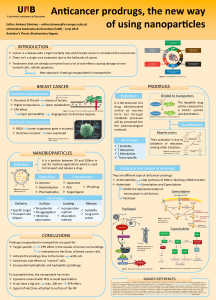




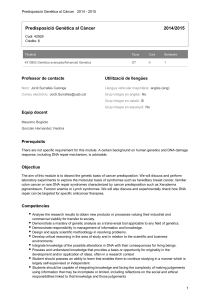
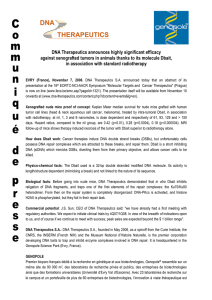
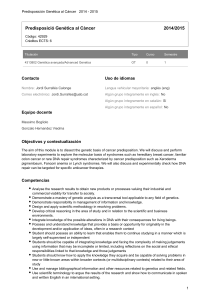
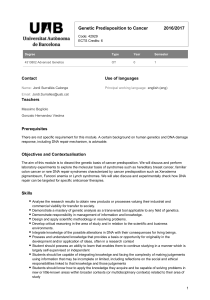
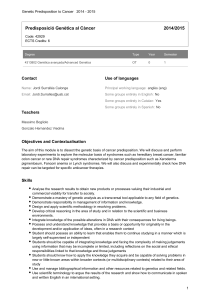
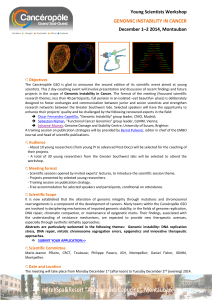
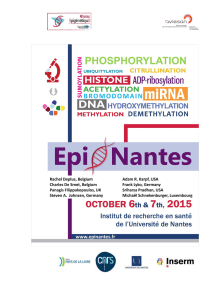
![This article was downloaded by: [University of Liege] On: 22 January 2009](http://s1.studylibfr.com/store/data/008518356_1-e6e133fbe82fa051365aadcc0fa1b182-300x300.png)
